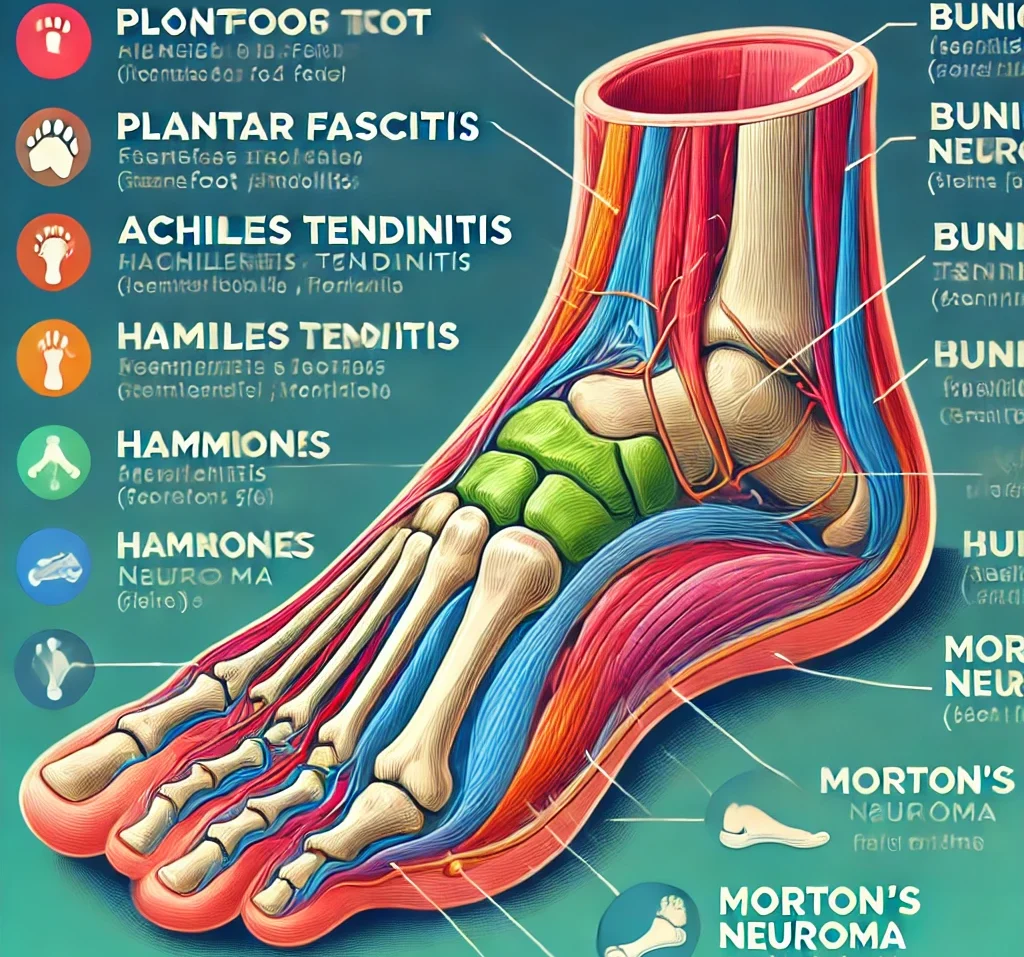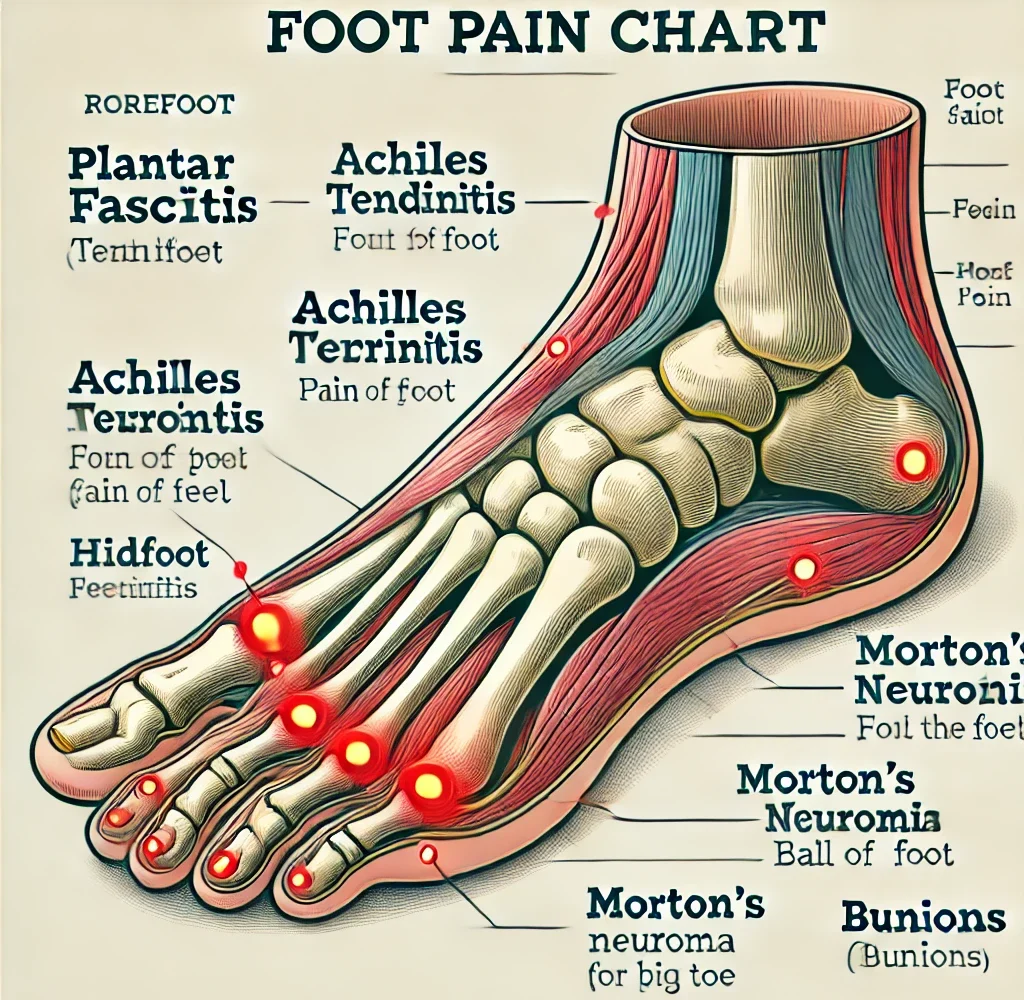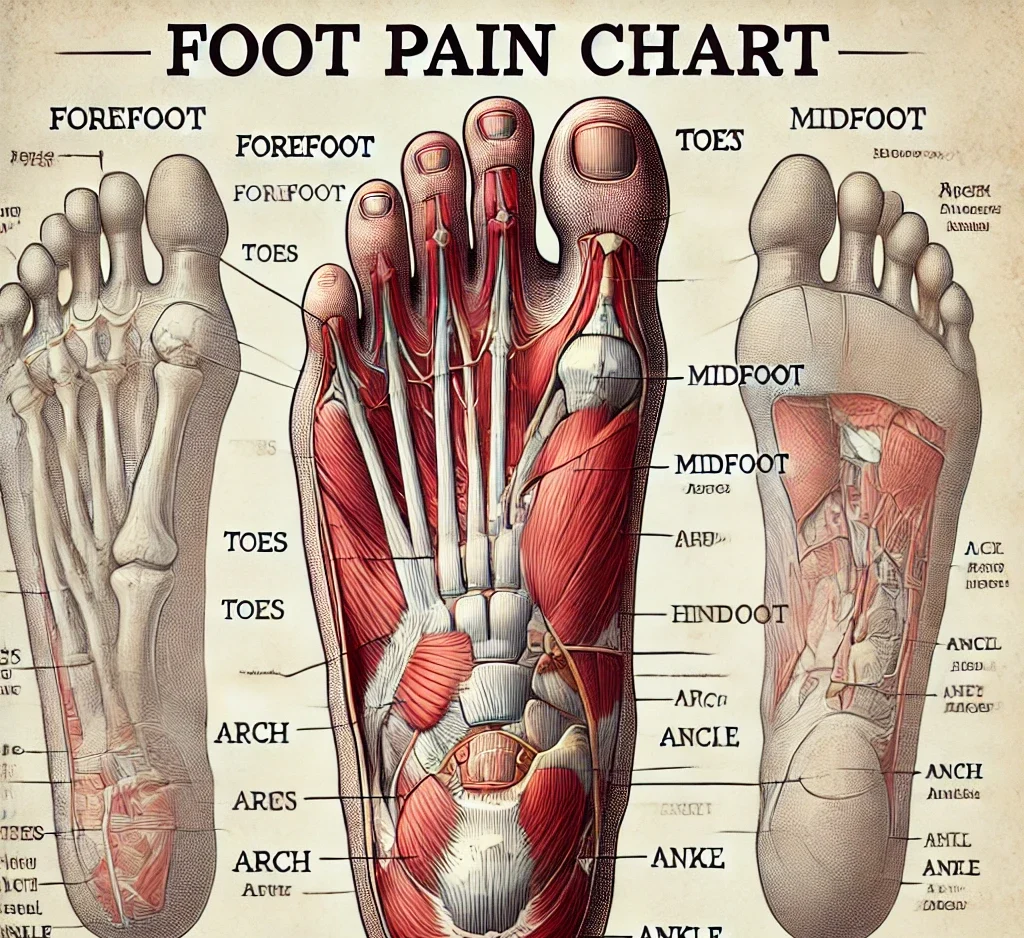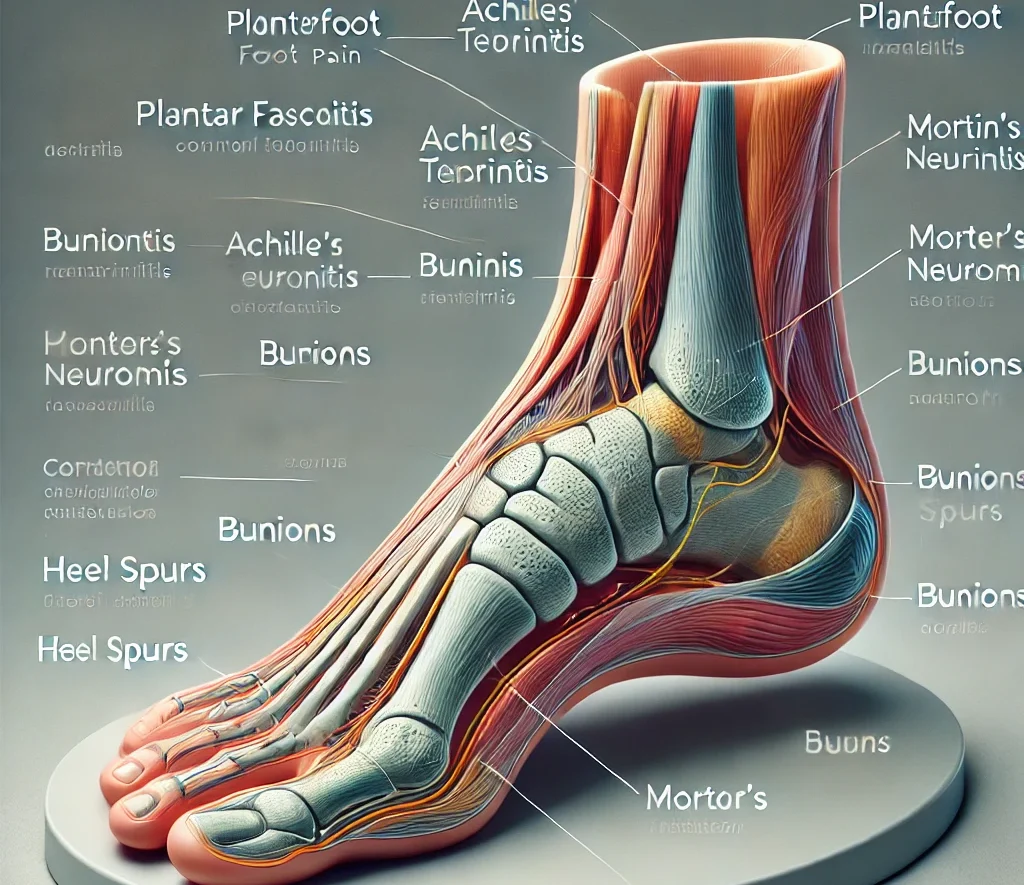Table of Contents
ToggleIntroduction to Foot Pain chart
Understanding Foot Pain chart
foot pain chart is a common ailment that can significantly impact daily activities and overall quality of life. It can manifest in various forms, ranging from mild discomfort to severe, debilitating pain. Understanding foot pain chart involves recognizing its diverse manifestations and the numerous factors that can contribute to it. Foot pain chart can arise from acute injuries, such as sprains and fractures, or from chronic conditions like arthritis and plantar fasciitis. It is essential to pay attention to the type, location, and severity of the pain to accurately diagnose and treat it.

Common Causes of Foot pain chart
There are numerous potential causes of foot pain chart, each affecting different parts of the foot. Some of the most common causes include plantar fasciitis, which is inflammation of the tissue that runs along the bottom of the foot, and Achilles tendinitis, which affects the tendon connecting the calf muscles to the heel. Other frequent culprits are bunions, hammertoes, and Morton’s neuroma. Additionally, conditions such as flat feet or high arches can lead to biomechanical issues, resulting in pain. Injuries like sprains, fractures, and overuse can also cause significant discomfort. Understanding these common causes is vital for effective treatment and prevention.
Importance of Addressing Foot Pain Chart Early
Addressing foot pain chart early is crucial for preventing long-term complications and ensuring optimal foot health. Ignoring or delaying treatment can lead to worsening pain and further damage, potentially resulting in chronic issues that are more challenging to manage. Early intervention can often prevent minor problems from becoming major ones. Moreover, understanding and addressing the root cause of the pain can help in developing effective treatment plans, which may include rest, physical therapy, orthotics, or medical intervention. Early treatment also facilitates faster recovery and allows individuals to return to their normal activities with minimal disruption. Therefore, being proactive about foot pain chart is essential for maintaining mobility and overall well-being.
Pain Chart Anatomy and Pain Regions
Overview of pain chart Anatomy
The foot is a complicated anatomical system in humans, consisting of about 100 muscles, tendons, and ligaments along with 26 bones and 33 joints. It can be divided into three main parts: the forefoot, midfoot, and hindfoot. The forefoot includes the toes and the five metatarsal bones. The midfoot is formed by the arch of the foot, which includes the cuboid, navicular, and three cuneiform bones. The hind foot consists of the heel and ankle bones, specifically the talus and calcaneus. Each component of the foot plays a vital role in movement, balance, and weight distribution, making it essential to understand its anatomy to identify and treat foot pain charts effectively.
Regions of Foot Pain
Foot pain charts can be categorized based on the specific region where it occurs. The forefoot is prone to conditions like bunions, hammertoes, and Morton’s neuroma. Pain in the midfoot can be associated with issues such as flat feet, high arches, or arthritis. The hindfoot, including the heel and ankle, is often affected by plantar fasciitis, Achilles tendinitis, and heel spurs. Each region’s unique structure and function mean that the causes and treatments of pain can vary significantly. Identifying the exact location of foot pain chart is crucial for accurate diagnosis and effective management.
How Foot Anatomy Affects Pain
The intricate anatomy of the foot means that any structural or functional abnormalities can lead to pain. For example, an imbalance in the muscles or ligaments can cause uneven pressure distribution, leading to discomfort and injuries. Additionally, conditions affecting the bones, such as fractures or bone spurs, can directly result in pain. The foot’s natural arches act as shock absorbers, and any issues with the arch structure, such as flat feet or high arches, can lead to pain and discomfort. Understanding how the foot’s anatomy affects pain helps in diagnosing the root cause and developing a targeted treatment plan.
Using a Foot Pain Chart
What is a Foot Pain Chart?
A foot pain chart is a visual tool used to map out areas of pain in the foot and associate them with potential causes. It typically includes a diagram of the foot, divided into various regions, with common conditions linked to each area. This chart serves as a reference for identifying the location and possible reasons for foot pain chart, aiding both self-assessment and professional diagnosis. It is particularly useful for pinpointing specific pain points and understanding the underlying issues that might be contributing to discomfort.
How to Use a Foot Pain Chart
Using a foot pain chart involves locating the area of discomfort on the foot diagram and referencing the associated conditions or causes listed for that region. Begin by identifying the exact spot where the pain is most pronounced, whether it is in the forefoot, midfoot, or hindfoot. Once the location is determined, consult the chart to see the potential conditions related to that area. For instance, if the pain is in the heel, the chart might indicate plantar fasciitis or heel spurs as possible causes. This process helps narrow down potential issues and guides further investigation or professional consultation.
Benefits of a Foot Pain Chart
A foot pain chart offers several benefits, including simplifying the process of identifying and understanding foot pain chart. It provides a clear visual representation of where pain occurs and its potential causes, making it easier to communicate symptoms to healthcare professionals. This tool can also help in early detection and intervention, as recognizing patterns of pain can prompt timely treatment. Additionally, it empowers individuals to take an active role in managing their foot health by providing insights into common conditions and guiding self-care practices. Overall, a foot pain chart is an invaluable resource for both patients and healthcare providers in diagnosing and treating foot pain charts effectively.

Common Foot Pain chart Conditions
Plantar Fasciitis
Plantar fasciitis is one of the most common causes of heel pain. It occurs when the plantar fascia, the thick band of tissue running across the bottom of the foot connecting the heel bone to the toes, becomes inflamed. This condition often results in stabbing pain, especially during the first steps in the morning. Risk factors include prolonged standing, obesity, and high-impact activities. Treatment typically involves rest, stretching exercises, orthotics, and anti-inflammatory medications. In severe cases, physical therapy or surgical intervention may be necessary.
Achilles Tendinitis
The overuse injury known as Achilles tendinitis affects the tendon that attaches the heel bone to the calf muscles. This condition commonly affects runners and individuals who suddenly increase the intensity or duration of their physical activities. Symptoms include pain and stiffness along the Achilles tendon, swelling, and limited range of motion in the ankle. Treatment focuses on reducing inflammation and relieving pain through rest, ice, compression, and elevation (RICE). Stretching exercises, physical therapy, and proper footwear can also help in managing symptoms and preventing recurrence.
Morton’s Neuroma
Morton’s neuroma involves the thickening of tissue around one of the nerves leading to the toes, usually between the third and fourth toes. This condition causes sharp, burning pain in the ball of the foot, which may radiate into the toes. It can also cause numbness or a sensation of having a pebble in the shoe. High heels, tight shoes, and repetitive stress are common contributing factors. Treatment options include changing footwear, using orthotics, anti-inflammatory medications, and, in some cases, corticosteroid injections. If non-operative measures are ineffective, surgery might be taken into consideration.
Diagnosing Foot Pain Chart
Self-Assessment Techniques
Self-assessment techniques are crucial for understanding the nature and severity of foot pain chart. Start by examining the foot for visible signs of injury, such as swelling, redness, or deformities. Note the exact location of the pain and any specific activities that exacerbate or alleviate it. Keep a pain diary to track patterns and triggers. Gentle stretching and movement can help identify limitations in range of motion. Using these observations, you can make informed decisions about the next steps, whether it involves home care or seeking professional help.
When to See a Doctor
While many cases of foot pain chart can be managed with self-care, it is important to know when to seek medical attention. If the pain is severe, persistent, or accompanied by swelling, redness, or warmth, it may indicate a serious condition requiring professional intervention. Sudden onset of intense pain, inability to bear weight, or signs of infection should prompt an immediate visit to a healthcare provider. Additionally, if home treatments are ineffective after a few weeks, consulting a doctor is advisable to prevent complications and receive a proper diagnosis.
Diagnostic Tests for Foot pain chart
Diagnostic tests for foot pain chart help in pinpointing the exact cause and formulating an appropriate treatment plan. Common tests include X-rays, which can reveal fractures, bone spurs, and alignment issues. MRI and ultrasound imaging are useful for detecting soft tissue injuries, such as ligament tears, tendonitis, and neuromas. Blood tests may be conducted to identify underlying conditions like gout or infections. In some cases, a nerve conduction study might be necessary to diagnose nerve-related issues. These diagnostic tools, combined with a thorough clinical examination, ensure an accurate diagnosis and effective management of foot pain.
Treatment Options for Foot pain chart
Home Remedies and Self-C Care
Home remedies and self-care are often the first line of defense against foot pain chart. It’s important to rest the afflicted foot and stay away from activities that make the discomfort worse. Applying ice to the painful area for 15-20 minutes several times a day can reduce inflammation and numb soreness. Acetaminophen or ibuprofen, two over-the-counter pain medications, can assist control discomfort.Elevating the foot and using compression can also aid in reducing swelling. Gentle stretching exercises and massaging the foot can improve blood circulation and alleviate stiffness. These simple yet effective strategies can significantly relieve minor foot pain chart and prevent it from worsening.

Medical Treatments
When home remedies are insufficient, medical treatments may be necessary to address foot pain. Depending on the underlying cause, doctors might prescribe stronger anti-inflammatory medications or corticosteroid injections to reduce severe inflammation and pain. Orthotic devices, such as custom-made insoles, can provide better support and alignment, alleviating pressure on the painful areas. In cases of infections, antibiotics may be prescribed. For chronic or severe conditions, surgical intervention might be considered. Surgeries can range from minimally invasive procedures to correct deformities to more extensive operations for issues like severe bunions or neuromas.
Physical Therapy and Exercises
Physical therapy plays a vital role in treating and preventing foot pain chart. A physical therapist can design a personalized exercise program to strengthen the muscles and tendons in the foot, improve flexibility, and enhance overall foot function. Common exercises include calf stretches, toe curls, and arch strengthening routines. Physical therapy may also involve manual techniques like massage and mobilization to reduce pain and improve mobility. Additionally, therapists can provide guidance on proper gait and posture to prevent future injuries. Consistent physical therapy can accelerate recovery and help maintain foot health over the long term.
Preventing Foot Pain
Proper Footwear
Wearing proper footwear is essential for preventing foot pain chart. Shoes should provide adequate support, cushioning, and fit correctly to avoid unnecessary pressure on any part of the foot. It is important to choose shoes designed for specific activities, such as running shoes for jogging and sturdy, supportive shoes for hiking. Avoiding high heels and shoes with narrow toe boxes can prevent conditions like bunions and hammertoes. Regularly replacing worn-out shoes ensures continued support and comfort. Investing in high-quality, well-fitting shoes is a crucial step in maintaining foot health and preventing pain.
Foot Care Tips
Taking care of your feet daily can prevent many common foot problems. Keep your feet clean and dry to avoid infections, and trim your toenails straight across to prevent ingrown nails.Regularly moisturise your feet to keep them from drying out and cracking. Pay attention to any changes in your feet, such as swelling, redness, or pain, and address them promptly. Wearing socks that wick away moisture can prevent blisters and fungal infections. Additionally, giving your feet a break by elevating them can reduce swelling and fatigue. These simple foot care practices can go a long way in maintaining healthy feet.
Exercises to Strengthen Feet
Regular exercises to strengthen the feet can help prevent foot pain and improve overall foot function. Toe curls, where you pick up small objects with your toes, can strengthen the muscles in the toes and arch. Heel raises, where you stand on your toes and then lower your heels, can strengthen the calves and Achilles tendon. Arch lifts, where you lift the arch of your foot while keeping your toes and heel on the ground, can help strengthen the intrinsic muscles of the foot. Incorporating these exercises into your routine can enhance foot strength, flexibility, and stability, reducing the risk of injuries and pain.
Living with Chronic Foot Pain
Coping Strategies
Living with chronic foot pain chart requires effective coping strategies to manage daily discomfort and maintain a good quality of life. One essential strategy is pacing activities to avoid overexertion and taking regular breaks to rest the feet. Utilizing pain management techniques such as heat or cold therapy can provide temporary relief. Mindfulness and relaxation techniques, such as deep breathing exercises or meditation, can help manage pain by reducing stress and improving mental well-being. Additionally, using supportive footwear and orthotics can help alleviate pressure and provide comfort. Staying physically active within limits and engaging in low-impact exercises like swimming or cycling can also improve overall foot health and reduce pain.
Support and Resources
Seeking support and utilizing available resources can make a significant difference in managing chronic foot pain. Joining support groups, either in person or online, can provide emotional support and practical advice from others experiencing similar issues. Consulting with healthcare professionals, including podiatrists, physical therapists, and pain specialists, can offer specialized treatment options and guidance. Accessing educational materials, such as books, articles, and reputable websites, can provide valuable information on managing chronic foot pain. Additionally, exploring alternative therapies like acupuncture, massage, or chiropractic care may offer supplementary relief and improve overall well-being.

Long-Term Management
Long-term management of chronic foot pain chart involves a comprehensive approach to prevent exacerbation and maintain foot health. Developing a personalized pain management plan with the help of healthcare professionals is crucial. This plan may include a combination of medication, physical therapy, and lifestyle modifications. Regular check-ups with a podiatrist can help monitor the condition and make necessary adjustments to the treatment plan. Maintaining a healthy weight can reduce pressure on the feet and alleviate pain. Adopting ergonomic practices, such as using cushioned mats or supportive footwear, can minimize strain during daily activities. Consistently practicing good foot care and engaging in appropriate exercises can help manage chronic foot pain chart effectively over the long term.
Conclusion
Understanding and managing foot pain chart is essential for maintaining an active and healthy lifestyle. By recognizing the various causes of foot pain chart and how different regions of the foot can be affected, individuals can take proactive steps to address discomfort and prevent further issues. Utilizing tools such as a foot pain chart can aid in the self-assessment and early identification of potential problems, leading to timely and effective treatment.From home remedies and self-care to professional medical treatments and physical therapy, there are numerous ways to manage foot pain chart. Preventive measures, including proper footwear, regular foot care, and exercises to strengthen the feet, play a crucial role in avoiding pain and maintaining foot health.
Frequently Asked Questions (FAQs)
What are the most common causes of foot pain? The most common causes of foot pain chart include plantar fasciitis, Achilles tendinitis, bunions, hammertoes, Morton’s neuroma, flat feet, high arches, and injuries such as sprains and fractures. Each condition affects different parts of the foot and requires specific treatment approaches.
How can I use a foot pain chart to identify my pain? A foot pain chart helps you identify the location of your pain and associate it with potential causes. By pinpointing the exact area of discomfort on the chart, you can reference common conditions related to that region, aiding in self-assessment and facilitating discussions with healthcare professionals.
What are the best home remedies for foot pain? Effective home remedies for foot pain chart include resting the affected foot, applying ice to reduce inflammation, taking over-the-counter pain relievers, and performing gentle stretching exercises. Elevating the foot and using compression can also help alleviate pain and swelling.
When should I see a doctor for foot pain? You should see a doctor if your foot pain chart is severe, persistent, or accompanied by swelling, redness, or warmth. Immediate medical attention is necessary for sudden, intense pain, inability to bear weight, or signs of infection. If home treatments do not provide relief after a few weeks, consulting a healthcare provider is advisable.
How can proper footwear prevent foot pain? Proper footwear provides adequate support, cushioning, and a good fit, which can prevent unnecessary pressure on any part of the foot. Choosing shoes designed for specific activities, avoiding high heels and narrow toe boxes, and regularly replacing worn-out shoes are essential practices to maintain foot health and prevent pain.

